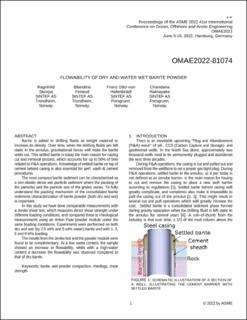| dc.contributor.author | Skorpa, Ragnhild | |
| dc.contributor.author | Feneuil, Blandine Fleur Prudence | |
| dc.contributor.author | von Hafenbrädl, Franz O. | |
| dc.contributor.author | Ratnayake, Chandana | |
| dc.date.accessioned | 2022-12-16T08:23:10Z | |
| dc.date.available | 2022-12-16T08:23:10Z | |
| dc.date.created | 2022-11-29T17:34:23Z | |
| dc.date.issued | 2022 | |
| dc.identifier.citation | International Conference on Offshore Mechanics and Arctic Engineering (OMAE) [proceedings]. 2022, 1-6. | en_US |
| dc.identifier.issn | 1523-651X | |
| dc.identifier.uri | https://hdl.handle.net/11250/3038153 | |
| dc.description.abstract | Barite is added to drilling fluids as weight material to increase its density. Over time, when the drilling fluids are left static in the annulus, gravitational forces will make the barite settle out. This settled barite is today the main reason for casing cut and removal process, which accounts for up to 50% of time related to P&A operations. Knowledge of settled barite on top of cement behind casing is also essential for perf, wash & cement procedures. The most compact barite sediment can be characterized as a non-elastic dense wet particle sediment where the packing of the particles and the particle size of the grains varies. To fully understand the packing mechanism of the consolidated barite sediments characterization of barite powder (both dry and wet) is important. In this study we have done comparable measurements with a Jenike shear test, which measures direct shear strength under different loading conditions, and compared these to rheological measurements using an Anton Paar powder module under the same loading conditions. Experiments were performed on both dry and wet (by 2.5 wt% and 5 wt% water) barite and with 1, 3, 6 and 9 kPa loading. The results from the Jenike test and the powder module were found to be complimentary. At a low water content, the sample showed an increase in flowability, while with a high-water content a decrease the flowability was observed compared to that of dry barite. | en_US |
| dc.language.iso | eng | en_US |
| dc.publisher | ASME | en_US |
| dc.subject | shear strength | en_US |
| dc.subject | rheology | en_US |
| dc.subject | wet powder compaction | en_US |
| dc.subject | barite | en_US |
| dc.title | Flowability of Dry and Water Wet Barite Powder | en_US |
| dc.title.alternative | Flowability of Dry and Water Wet Barite Powder | en_US |
| dc.type | Peer reviewed | en_US |
| dc.type | Journal article | en_US |
| dc.description.version | acceptedVersion | en_US |
| dc.rights.holder | Copyright: 2022 ASME | en_US |
| dc.source.pagenumber | 1-6 | en_US |
| dc.source.journal | International Conference on Offshore Mechanics and Arctic Engineering (OMAE) [proceedings] | en_US |
| dc.identifier.doi | 10.1115/OMAE2022-81074 | |
| dc.identifier.cristin | 2084626 | |
| dc.relation.project | Norges forskningsråd: 309646 | en_US |
| dc.source.articlenumber | V010T11A03 | en_US |
| cristin.ispublished | true | |
| cristin.fulltext | postprint | |
| cristin.qualitycode | 1 | |
